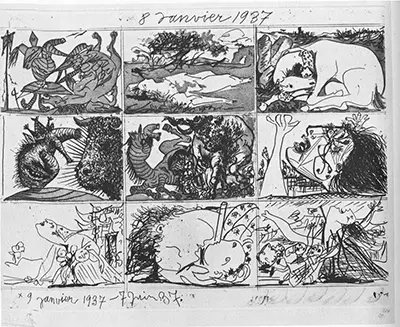The Dream and Lie of Franco II was one of Picasso's earliest politically themed works, and not of his usual artistic style. This series of 9 miniature paintings are satirical and cartoonish in nature, while they openly satirise General Franco and his claims of representing the true moral and ethical values of the Spanish people. Picasso despised him and The Dream and Lie of Franco II openly displays his antagonistic feelings.
This series of 9 caricatures shows Franco in states of absolute ridicule. The individual images were not originally intended to form one large focussed image, but rather had been drawn as individual postcards. This was done with the intention of raising much needed money for the government of the time, the Spanish Republic. Picasso had planned to sell them during 1937 at the Spanish Pavilion World Fair. It is still not known if any of the original images were made into postcards and sold as individual prints after they were formed together as one collection.
During 1937, acclaimed art historian at the time, Anthony Blunt, declared that The Dream and Lie of Franco II was of limited value, with many of the Spanish population not understanding its true satirical nature. Acclaimed author, John Golding, however disagreed with this sentiment, believing instead that this particular work of art could indeed break down barriers and have huge political influence in sending a strong message of unity to the Spanish people. He believed that it was a true work of the Surrealistic moment and that it would cross the boundaries of art, poetry and thought, beautifully blending them into one art form.

